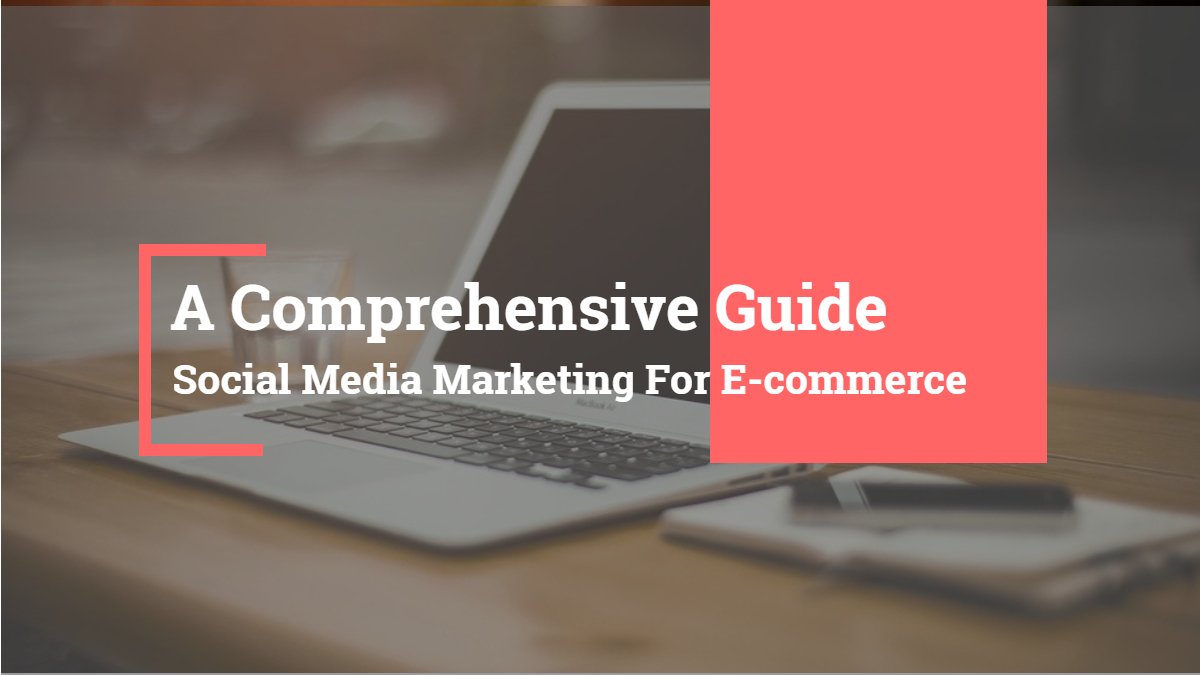Your website is the core of your social media planning. Your strategy depends on the way you line up your social media initiatives towards its different goals. Social media marketing for eCommerce can benefit your business by driving traffic and revenue, promoting brand awareness, gathering an engaged audience, interacting with consumers and potential prospects and extending support to your brand. Achieving conversions from social media is immense as it receives people’s attention and has millions of active followers.
What a Social Media Marketing Strategy Is About
For making things convenient, there are six main pillars to take into account when crafting your social media blueprint:

Raise Brand Awareness
Access more people to raise the chances of brand visibility by the right audience. You can evaluate it through impressions, shares, likes, mentions or any different signs that indicate that a real individual has viewed your posts.
Picking the Perfect Social Media Platforms
Choosing the correct social media platform would direct you towards the proper audience. Like for instance, if you are a graphics designer, you must go after Instagram or Dribble and upload your designs on such platforms instead of tweeting about them or exchanging your work folders with your Facebook page followers. The right platform makes you reach the right audience which is central to social media interactions.
Interacting With Your Audience
Following the selection of the correct platform to reach out, the next step is beginning a conversation through different modes and replying to the queries and opinions of your followers in a manner that brings value to one and all. Such interaction can take place through content creation like blogs, infographics, podcast or video and dishing it out for their consumption. Once they consume and react to your contention interaction starts. Likewise, YouTube, blog posts and also Reddit comments are important to know your audience and steer ahead. You can also interact with your prospects by creating an email list or through the phone.
Obtain Leads & Achieve Sales
Convert your audience into email subscribers, which you can cultivate into sales off for social media as free. This also helps to gather an interested shopper base that can be retargeted with ads. They are your paying customers achieved by you through social media efforts and measured from revenue or number of orders.
Networking to forge collaborations: Communicate with influencers or brands that are like-minded for influencer marketing or co-marketing initiatives.
Build Social Proof
Generate positive testimonials or developed content by influencers/consumers that showcase your brand in a favorable manner
Source positive testimonials or content created by influencers or consumers that build your brand in a positive outlook that can be applied for further marketing efforts.
Four Reasons For A Social Media Marketing Strategy For Your eCommerce Business

1. Explore the Potential Audience
E-commerce business is ever on the lookout for a new customer base. Things can begin to happen for your e-outlet if you begin to discover new faces. Carving a social media strategy helps to locate your potential audience and charters the course to reach out towards them. Whey you operate a Facebook ad, the set up of the ad demands the specifications of your audience whom you target to display your ad to the proper audience. This helps you to navigate your social media marketing strategy in the direction of the new audience. Hence, precisely, one of the advantages of creating a social media strategy is to discover the new audience.
2. Push Higher Sales
Directing sales towards the business is not the final objective of utilizing social media, but facilitates the bringing of people inside the engagement funnel. After entering the funnel, people interact with the brand or try out the website more frequently. Though, there are stages undergone by a follower prior to becoming a dedicated paid customer.
In fact, brands that utilize social media for engagement, networking with the audience, and communicating with the new faces bring more conversions compared to the ones only seeking sales from social media. To achieve higher sales in the long run, e-commerce businesses must use social media to disseminate the word and improve their fan following.
3. Build a Community
A community comprises the crux of a social media marketing campaign. While gaining followers or making viral content, you do require an active community for brand building. Many brands acknowledge this concept, and try out everything in their arsenal to make things happen.
Your e-commerce business is similar to a SAAS company – you must take recourse to ways to create a powerful community whether it is a blog, social media or a newsletter.
4. Interact through Retargeting
Your social media planning involves displaying content, marketing through social networking sites, interacting with people, and sharing the content of others – in-between all such activity, you can retarget your site visitors.
The process of retargeting website visitors includes advertising to the particular audience that visited your portal via social media. An amazing tool for it is a Facebook ad. Google Adwords schedule permits you to do that.
Retargeting is a basic aspect of social media conversions. Often, you must have viewed the ads of your preferred online stores on Facebook the moment you visited those websites. This is their strategy to engage you once more for bettering their conversion rate.
Ways To launch Social Media Marketing For eCommerce Outlet

Social media takes your engagement with your prospects a notch higher. Given below are the ways to achieve it in a phased manner through social media marketing for your e-commerce outlets:
#1. Select Proper Social Media Channels
Any concept of developing a social media marketing strategy fails without taking into account a select number of social media channels to participate in. You have to plan your social media strategy by monitoring :
- Time spent by your audience on what platforms
- Their brand and product preferences
- Their favorite social apps
- Outreaching the target audience
- Demographics of the potential prospects
- The purchasing behaviors of the present consumers
- Consumers likes and dislikes.
What stands out in social media is quality, not simply quantity. Performing in tow or three social media channels with steady, captivating content that interacts with your potential audience ultimately results in both customers and conversions.
#2. Generate A Plan For Audience Engagement
You require a strategy of audience engagement through different tactics. Like for example, if you write an engaging Facebook status, and your circle of friends like and express their comments about it, there is a higher chance of its outreach to people in your circuit. This is the way engagement operates within social media.
In the case of e-commerce business, you have to initiate processes and concepts that retain the audience like a monthly discount coupon segment on your website where rebates are given upon particular domain registration.
This creates a sense of alarm for your users and the fear of missing out which brings them back to your site.
Canva realizes the significance of audience engagement, as they reply to every single tweet be it 400 or 400,000 fan base, you have every possibility to receive a reply from them if you inquire about something on Twitter.
Social media engagement can take place in various forms such as:
- Post/blog comments
- Retweet on your tweet
- Resharing of your blog
- A tweet reply
- Likes for your post or article
- Direct Messaging
- Mention in the comment or status
The four essential components of a plan for audience engagement involves:
a.) Displaying various content to engage and convert the audience into purchasing customers. Every e-commerce outlet must develop content be it audio, video, images or written and run an instagram account
b.) Know the best time to post on social media as the social media timings of your audience differs.
c.) Scheduling content on social media
d.) Repurposing the content by picking one type of content and generating a different type of content from the outline of the original content on a different platform.
#3. Boost Your Conversion Rate
An indicator of the success of your e-commerce store would include the conversion rate. The conversion rate is measured by dividing sales over full total visitors. Like for example if total visitors amounted to 100 and 10 bought the products, the conversion rate would be 10%. An improved conversion rate raises profit.
Among the key elements that boost your conversion rate through social media is remarketing.
Some further steps that can enhance the conversion rate are:
- Adding Facebook Pixel to your site that is a Facebook code that retargets your site visitors through Facebook ads
- Running Facebook ads directed towards your specific audience and watch the way it works
- Using a drip marketing campaign which involves a trigger dependent campaign that includes some form of action on the site or within the email. If a purchaser views a product on the site without completing the purchase, the drip marketing campaign could trigger the mail offering a rebate on the product or an email inquiring about the decision on purchasing that very product.
#4. Assess the Performance of Your Social Media Account
Performance analysis helps to evaluate the effects of your techniques and planning to gauge its success and the performance of your social media strategy. You can assess it by measuring your social media followers and numbers.
Watch out the alterations in the shares, likes, comments and fan base. Also, check out the engagement in the form of responses and questions you received during a particular period, more so after making alterations in your social media planning. Watch closely your email figures, comments, and social media messages to evaluate your implemented strategy.
A rise in the profits by way of conversion of your clients after incorporating the social media strategy shows that your content and social media plans are performing for you.
Final Thoughts
Social media assists online marketing by helping organizations to build a powerful web presence, grow leads and augment traffic. A properly structured social media strategy is crucial for the expansion and growth of your e-commerce business. Social media sites are the place where advertising campaigns generate and are a major platform for reviews, buying choices and is an effective method to captivate and engage your future prospects and audiences.
Promote your e-commerce stores through such direct engagement with your customers – be it through feedback, holding contests or updating status messages, Pinterest boards or Viral video campaigns on YouTube.






